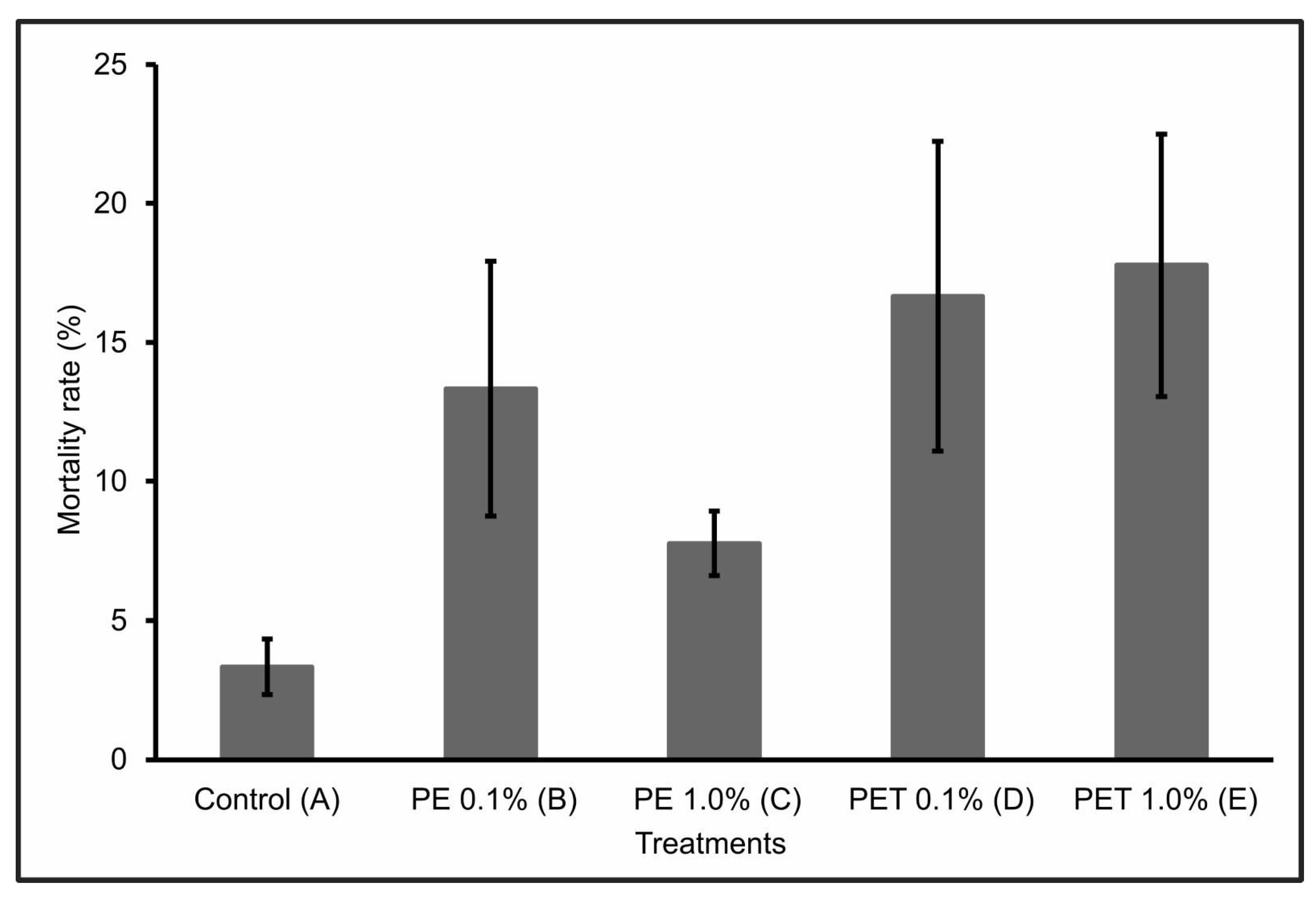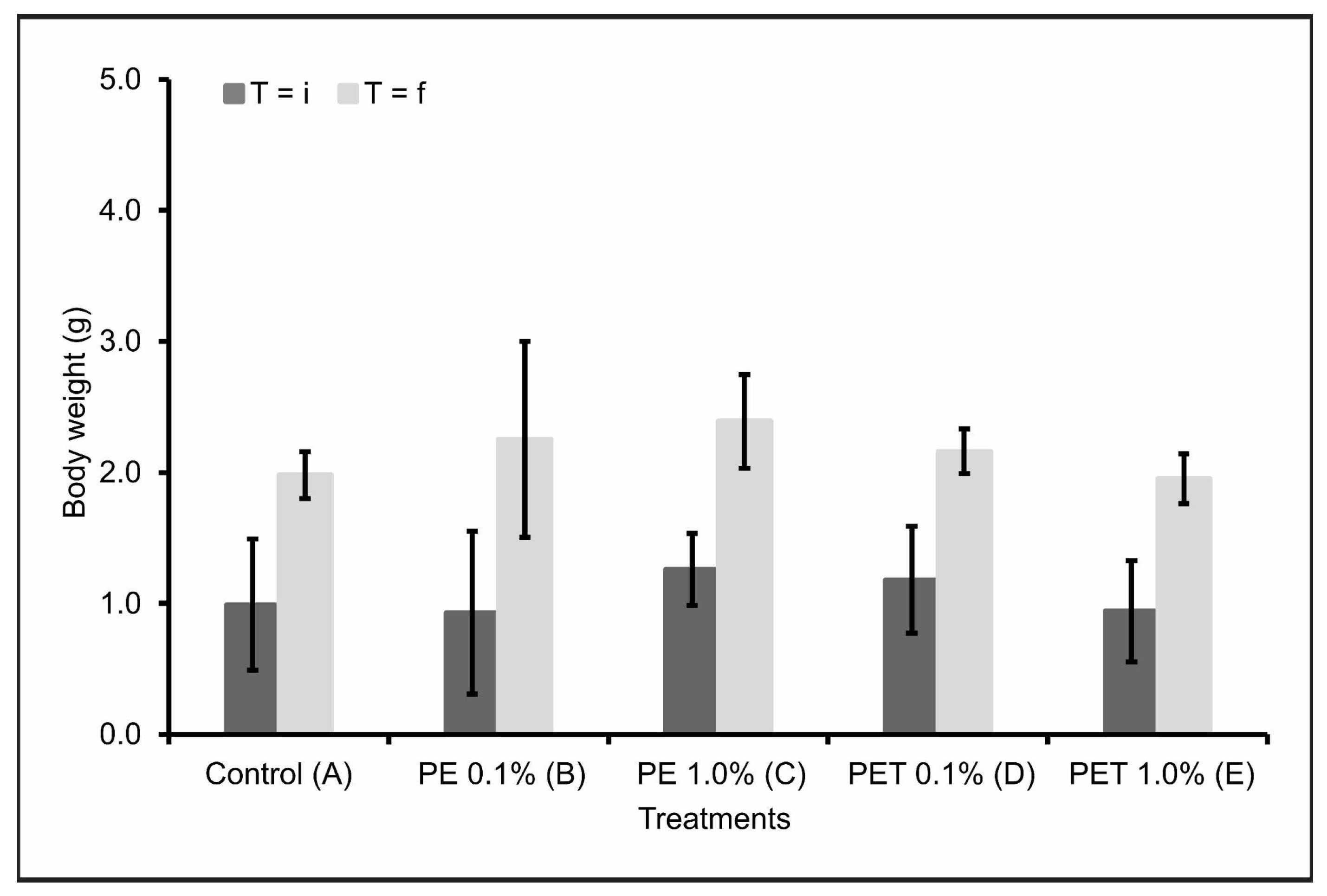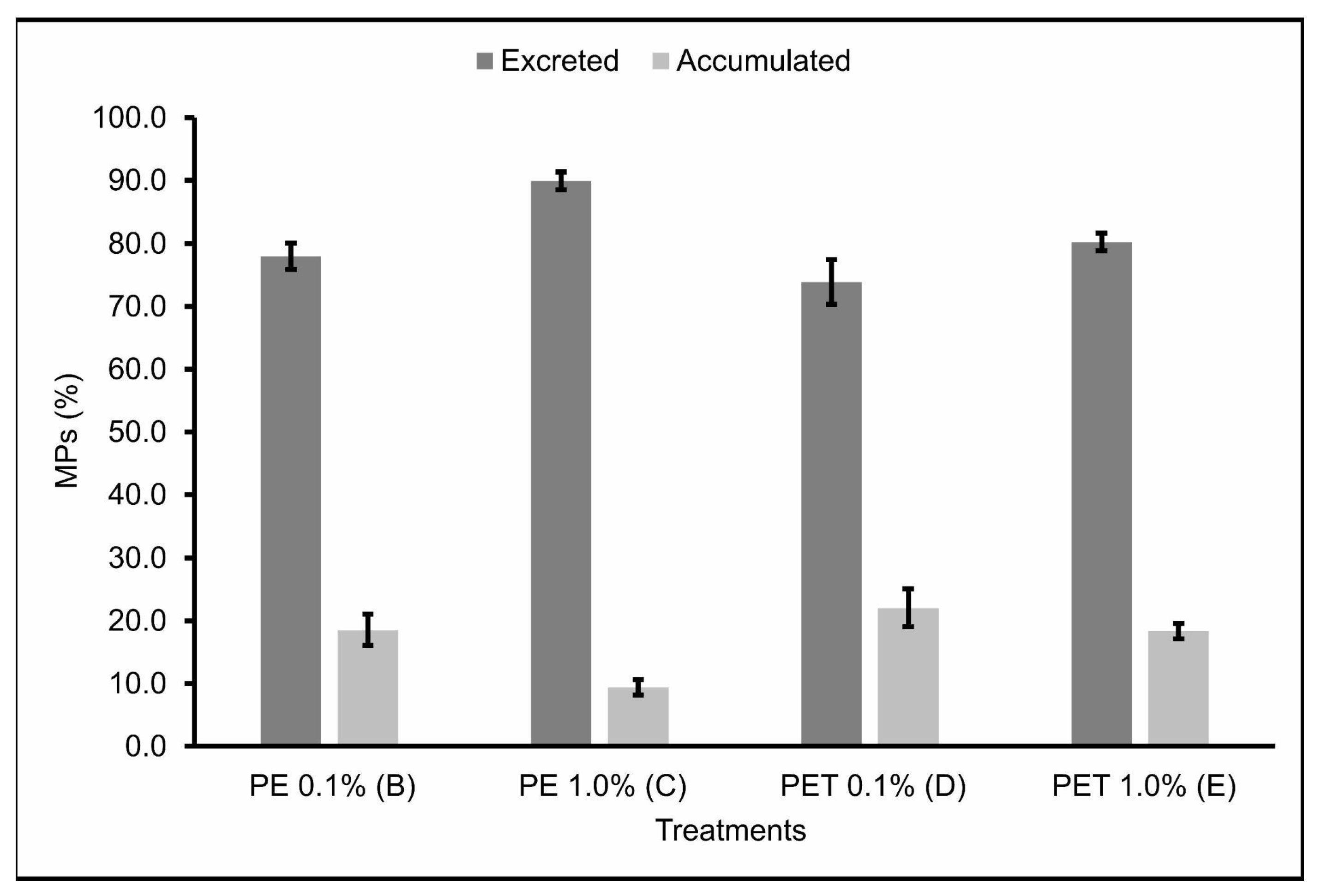Effects Caused by the Ingestion of Microplastics: First Evidence in the Lambari Rosa (Astyanax altiparanae)
Abstract
:Simple Summary
Abstract
1. Introduction
2. Materials and Methods
2.1. Experimental Design
2.2. Preparation of the Feed Used in the Lambari Rosa Diet
2.3. Analysis of the Effects of Exposing Fish to a Diet Containing MPs
2.4. Retention of MPs in the Gastrointestinal Tract and Elimination through Feces
2.5. Analysis of the Results
3. Results and Discussion
3.1. Toxicological Parameters
3.1.1. Mortality
3.1.2. Weight
3.1.3. Malformations
3.2. Ingestion and Excretion of MPs
4. Conclusions
Author Contributions
Funding
Institutional Review Board Statement
Informed Consent Statement
Data Availability Statement
Acknowledgments
Conflicts of Interest
References
- Cole, M.; Lindeque, P.; Halsband, C.; Galloway, T.S. Microplastics as contaminants in the marine environment: A review. Mar. Pollut. Bull. 2011, 62, 2588–2597. [Google Scholar] [CrossRef]
- Hale, R.C.; Seeley, M.E.; Guardia, M.J.; Mai, L.; Zeng, E.Y. A global perspective on microplastics. J. Geophys. Res. Oceans 2020, 125, e2018JC014719. [Google Scholar] [CrossRef]
- Olivatto, G.P.; Carreira, R.; Tornisielo, V.L.; Montagner, C.C. Microplásticos: Contaminantes de preocupação global no Antropoceno. Rev. Virtual Quím. 2018, 10, 1968–1989. [Google Scholar] [CrossRef]
- Hidalgo-Ruz, V.; Gutow, L.; Thompson, R.C.; Thiel, M. Microplastics in the marine environment: A review of the methods used for identification and quantification. Environ. Sci. Technol. 2012, 46, 3060–3075. [Google Scholar] [CrossRef] [PubMed]
- Ricciardi, M.; Pironti, C.; Motta, O.; Miele, Y.; Proto, A.; Montano, L. Microplastics in the Aquatic Environment: Occurrence, Persistence, Analysis, and Human Exposure. Water 2021, 13, 973. [Google Scholar] [CrossRef]
- Li, C.; Busquets, R.; Campos, L.C. Assessment of microplastics in freshwater systems: A review. Sci. Total Environ. 2020, 707, 135578. [Google Scholar] [CrossRef] [PubMed]
- Cesa, F.S.; Turra, A.; Baruque-Ramos, J. Synthetic fibers as microplastics in the marine environment: A review from textile perspective with a focus on domestic washings. Sci. Total Environ. 2017, 598, 1116–1129. [Google Scholar] [CrossRef]
- Garcia, T.D.; Cardozo, A.L.P.; Quirino, B.A.; Yofukuji, K.Y.; Ganassin, M.J.M.; Santos, N.C.L.; Fugi, R. Ingestion of microplastic by fish of different feeding habits in urbanized and non-urbanized streams in Southern Brazil. Water Air Soil Pollut. 2020, 231, 434. [Google Scholar] [CrossRef]
- Jabeen, K.; Su, L.; Li, J.; Yang, D.; Tong, C.; Mu, J.; Shi, H. Microplastics and mesoplastics in fish from coastal and fresh waters of China. Environ. Pollut. 2017, 221, 141–149. [Google Scholar] [CrossRef]
- Zhu, L.; Wang, H.; Chen, B.; Sun, X.; Qu, K.; Xia, B. Microplastic ingestion in deep-sea fish from the South China Sea. Sci. Total Environ. 2019, 677, 493–501. [Google Scholar] [CrossRef]
- Courtene-Jones, W.; Clark, N.J.; Fischer, A.C.; Smith, N.S.; Thompson, R.C. Ingestion of microplastics by Marine Animals. In Plastics and the Ocean: Origin, Characterization, Fate, and Impacts; Andrady, A.L., Ed.; John Wiley & Sons: Hoboken, NJ, USA, 2022; pp. 349–366. [Google Scholar] [CrossRef]
- Van Franeker, J.A.; Law, K.L. Seabirds, gyres and global trends in plastic pollution. Environ. Pollut. 2015, 203, 89–96. [Google Scholar] [CrossRef]
- Tang, Y.; Liu, Y.; Chen, Y.; Zhang, W.; Zhao, J.; He, S.; Yang, C.; Zhang, T.; Tang, C.; Zhang, C.; et al. A review: Research progress on microplastic pollutants in aquatic environments. Sci. Total Environ. 2021, 766, 142572. [Google Scholar] [CrossRef]
- Bajt, O. From plastics to microplastics and organisms. FEBS Open Bio 2021, 11, 954–966. [Google Scholar] [CrossRef]
- Triebskorn, R.; Braunbeck, T.; Grummt, T.; Hanslik, L.; Huppertsberg, S.; Jekel, M.; Knepper, T.P.; Krais, S.; Müller, Y.K.; Pittroff, M.; et al. Relevance of nano-and microplastics for freshwater ecosystems: A critical review. TrAC Trends Anal. Chem. 2019, 110, 375–392. [Google Scholar] [CrossRef]
- Grigorakis, S.; Mason, S.A.; Drouillard, K.G. Determination of the gut retention of plastic microbeads and microfibers in goldfish (Carassius auratus). Chemosphere 2017, 169, 233–238. [Google Scholar] [CrossRef] [PubMed]
- Jovanović, B.; Gökdağ, K.; Güven, O.; Emre, Y.; Whitley, E.M.; Kideys, A.E. Virgin microplastics are not causing imminent harm to fish after dietary exposure. Mar. Pollut. Bull. 2018, 130, 123–131. [Google Scholar] [CrossRef] [PubMed]
- Lu, Y.; Zhang, Y.; Deng, Y.; Jiang, W.; Zhao, Y.; Geng, J.; Ding, L.; Ren, H. Uptake and accumulation of polystyrene microplastics in zebrafish (Danio rerio) and toxic effects in liver. Environ. Sci. Technol. 2016, 50, 4054–4060. [Google Scholar] [CrossRef] [PubMed]
- Sun, X.; Li, Q.; Shi, Y.; Zhao, Y.; Zheng, S.; Liang, J.; Liu, T.; Tian, Z. Characteristics and retention of microplastics in the digestive tracts of fish from the Yellow Sea. Environ. Pollut. 2019, 249, 878–885. [Google Scholar] [CrossRef]
- Gomes, C.C.; Costa, F.G.; Borella, M.I. Distribution of GnRH in the brain of the freshwater teleost Astyanax altiparanae (Garutti & Britski, 2000). Micron 2013, 52, 33–38. [Google Scholar] [CrossRef]
- Nelson, J.S. Fishes of the World; John Wiley and Sons Inc.: Hoboken, NJ, USA, 2006. [Google Scholar]
- Garutti, V. Piscicultura Ecológica; Unesp: São Paulo, Brazil, 2003. [Google Scholar]
- Costa, F.G.; Adolfi, M.C.; Gomes, C.C.; Jesus, L.W.O.; Batlouni, S.R.; Borella, M.I. Testes of Astyanax altiparanae: The Sertoli cell functions in a semicystic spermatogenesis. Micron 2014, 61, 20–27. [Google Scholar] [CrossRef]
- de Paiva Camargo, M.; Cassel, M.; Oliveira de Jesus, L.W.; Nóbrega, R.H.; Borella, M.I. Characterization of undifferentiated spermatogonia and the spermatogonial niche in the lambari fish Astyanax altiparanae. Theriogenology 2017, 96, 97–102. [Google Scholar] [CrossRef]
- Martins, J.B.; Ribeiro, R.G.C.; Sanches, S.A.; Tolucci, C.E. Bioacumulação por Microplásticos e Seu Impacto na Saúde Pública. Undergraduate Course, Universidade Anhembi Morumbi, Piracicaba, São Paulo, Brazil, 2022. [Google Scholar]
- Porto-Foresti, F.; Castilho-Almeida, R.B.; Foresti, F. Biologia e criação do lambari-do-rabo-amarelo (Astyanax altiparanae). In Espécies Nativas para Piscicultura no Brasil; Baldisserotto, B., Gomes, L.C., Eds.; UFSM: Santa Maria, Rio grande do Sul, Brazil, 2005; pp. 101–116. [Google Scholar]
- Malafaia, G.; da Luz, T.M.; Araújo, A.P.C.; Ahmed, M.A.I.; Rocha-Santos, T.; Barceló, D. Novel methodology for identification and quantification of microplastics in biological samples. Environ. Pollut. 2022, 292, 118466. [Google Scholar] [CrossRef]
- Pannetier, P.; Morin, B.; Le Bihanic, F.; Dubreil, L.; Clérandeau, C.; Chouvellon, F.; Van Arkel, K.; Danion, M.; Cachot, J. Environmental samples of microplastics induce significant toxic effects in fish larvae. Environ. Int. 2020, 134, 105047. [Google Scholar] [CrossRef] [PubMed]
- Massago, H.; Da Silva, B.C. Desempenho do lambari-do-rabo-amarelo alimentado com rações práticas contendo diferentes níveis de proteína bruta. Rev. Agropecu. Catarin. 2020, 33, 67–71. [Google Scholar] [CrossRef]
- Mazurais, D.; Ernande, B.; Quazuguel, P.; Severe, A.; Huelvan, C.; Madec, L.; Mouchel, O.; Soudant, P.; Robbens, J.; Huvet, A.; et al. Evaluation of the impact of polyethylene microbeads ingestion in European sea bass (Dicentrarchus labrax) larvae. Mar. Environ. Res. 2015, 112, 78–85. [Google Scholar] [CrossRef]
- Ohkubo, N.; Ito, M.; Hano, T.; Kono, K.; Mochida, K. Estimation of the uptake and gut retention of microplastics in juvenile marine fish: Mummichogs (Fundulus heteroclitus) and red seabreams (Pagrus major). Mar. Pollut. Bull. 2020, 160, 111630. [Google Scholar] [CrossRef] [PubMed]
- Dhimmer, V.R. Microplastics in gastrointestinal tracts of Trachurus trachurus and Scomber colias from the Portuguese Coastal waters. Ph.D. Thesis, NOVA University Lisbon, Lisbon, Portugal, 2017. [Google Scholar]
- Luz, J.A.D. Caracterização de microplásticos em conteúdos de tratos gastrointestinais de peixes do estuário do Rio Tramandaí-Litoral Norte do Rio Grande do Sul através de digestão de tecidos biológicos. Undergraduation Course, Universidade Federal do Rio Grande do Sul, Rio Grande do Sul, Brazil, 2018. [Google Scholar]
- da Costa Araújo, A.P.; Malafaia, G. Can short exposure to polyethylene microplastics change tadpoles’ behavior? A study conducted with neotropical tadpole species belonging to order anura (Physalaemus cuvieri). J. Hazard. Mater. 2020, 391, 122214. [Google Scholar] [CrossRef]
- Ouyang, M.-Y.; Feng, X.-S.; Li, X.-X.; Wen, B.; Liu, J.-H.; Huang, J.-N.; Gao, J.-Z.; Chen, Z.-Z. Microplastics intake and excretion: Resilience of the intestinal microbiota but residual growth inhibition in common carp. Chemosphere 2021, 276, 130144. [Google Scholar] [CrossRef]
- Pedà, C.; Caccamo, L.; Fossi, M.C.; Gai, F.; Andaloro, F.; Genovese, L.; Perdichizzi, A.; Romeo, T.; Maricchiolo, G. Intestinal alterations in European sea bass Dicentrarchus labrax (Linnaeus, 1758) exposed to microplastics: Preliminary results. Environ. Pollut. 2016, 212, 251–256. [Google Scholar] [CrossRef]
- Long, M.; Moriceau, B.; Gallinari, M.; Lambert, C.; Huvet, A.; Raffray, J.; Soudant, P. Interactions between microplastics and phytoplankton aggregates: Impact on their respective fates. Mar. Chem. 2015, 75, 39–46. [Google Scholar] [CrossRef]
- Kaposi, K.L.; Mos, B.; Kelaher, B.P.; Dworjanyn, S.A. Ingestion of microplastic has limited impact on a marine larva. Environ. Sci. Technol. 2014, 48, 1638–1645. [Google Scholar] [CrossRef] [PubMed]
- Jabeen, K.; Li, B.; Chen, Q.; Su, L.; Wu, C.; Hollert, H.; Shi, H. Effects of virgin microplastics on goldfish (Carassius auratus). Chemosphere 2018, 213, 323–332. [Google Scholar] [CrossRef] [PubMed]
- Sussarellu, R.; Suquet, M.; Thomas, Y.; Lambert, C.; Fabioux, C.; Pernet, M.E.J.; Le Goïc, N.; Quillien, V.; Mingant, C.; Epelboin, Y.; et al. Oyster reproduction is affected by exposure to polystyrene microplastics. Proc. Natl. Acad. Sci. USA 2016, 113, 2430–2435. [Google Scholar] [CrossRef] [PubMed]
- Choi, J.S.; Jung, Y.J.; Hong, N.H.; Hong, S.H.; Park, J.W. Toxicological effects of irregularly shaped and spherical microplastics in a marine teleost, the sheepshead minnow (Cyprinodon variegatus). Mar. Pollut. Bull. 2018, 129, 231–240. [Google Scholar] [CrossRef]
- Azevedo-Santos, V.M.; Brito, M.F.G.; Manoel, P.S.; Perroca, J.F.; Rodrigues-Filho, J.L.; Paschoal, L.R.P.; Gonçalves, G.R.L.; Wolf, M.R.; Blettler, M.C.M.; Andrade, M.C.; et al. Plastic pollution: A focus on freshwater biodiversity. Ambio 2021, 50, 1313–1324. [Google Scholar] [CrossRef]
- Jakubowska, M.; Białowąs, M.; Stankevičiūtė, M.; Chomiczewska, A.; Pažusienė, J.; Jonko-Sobuś, K.; Hallmann, A.; Uban-Malinga, B. Effects of chronic exposure to microplastics of different polymer types on early life stages of sea trout Salmo trutta. Sci. Total Environ. 2020, 740, 139922. [Google Scholar] [CrossRef]
- Ong, H.T.; Samsudin, H.; Soto-Valdez, H. Migration of endocrine-disrupting chemicals into food from plastic packaging materials: An overview of chemical risk assessment, techniques to monitor migration, and international regulations. Crit. Rev. Food Sci. Nutr. 2022, 62, 957–979. [Google Scholar] [CrossRef]
- Sax, L. Polyethylene terephthalate may yield endocrine disruptors. Environ. Health Perspect. 2010, 118, 445–448. [Google Scholar] [CrossRef]
- Xu, X.; Zhou, G.; Lei, K.; LeBlanc, G.A.; An, L. Phthalate esters and their potential risk in PET bottled water stored under common conditions. Int. J. Environ. Res. Public Health 2020, 17, 141. [Google Scholar] [CrossRef]
- Costigan, E.; Collins, A.; Hatinoglu, M.D.; Bhagat, K.; MacRae, J.; Perreault, F.; Apul, O. Adsorption of organic pollutants by microplastics: Overview of a dissonant literature. J. Hazard. Mater. Adv. 2022, 6, 100091. [Google Scholar] [CrossRef]



| Experimental Design | ||
|---|---|---|
| Feed | ||
| Treatments | Control (A) | only tetraMin® extruded feed |
| PE 0.1 % (B) | tetraMin® extruded feed and 0.1% PE polymer MPs | |
| PE 1.0 % (C) | tetraMin® extruded feed and 1.0% PE polymer MPs | |
| PET 0.1 % (D) | tetraMin® extruded feed and 0.1% PET polymer MPs | |
| PET 1.0 % (E) | tetraMin® extruded feed and 1.0% PET polymer MPs | |
| MPs Found in the Gastrointestinal Tract (mg) and Feces (mg) after Feeding | |||
|---|---|---|---|
| Treatments | 2 h | 24 h | 48 h |
| MPs in Gastrointestinal Tract (mg) (n = 15) | |||
| PE 0.1% (B) | 1.65 ± 0.05 b | 0.98 ± 0.06 b | 0.33 ± 0.04 b |
| PE 1.0% (C) | 16.93 ± 0.06 a | 7.01 ± 0.09 a | 1.70 ± 0.22 a |
| PET 0.1% (D) | 1.68 ± 0.02 b | 1.05 ± 0.05 b | 0.40 ± 0.05 b |
| PET 1.0% (E) | 16.96 ± 0.07 a | 7.23 ± 0.03 c | 3.30 ± 0.22 c |
| MPs in Feces (mg) (n = 15) | |||
| PE 0.1% (B) | 0.13 ± 0.05 b | 0.66 ± 0.02 b | 0.62 ± 0.02 b |
| PE 1.0% (C) | 1.20 ± 0.29 a | 9.98 ± 0.06 a | 5.29 ± 0.15 a |
| PET 0.1% (D) | 0.09 ± 0.01 b | 0.61 ± 0.05 b | 0.62 ± 0.03 b |
| PET 1.0% (E) | 0.98 ± 0.04 a | 9.70 ± 0.08 a | 3.77 ± 0.29 c |
Disclaimer/Publisher’s Note: The statements, opinions and data contained in all publications are solely those of the individual author(s) and contributor(s) and not of MDPI and/or the editor(s). MDPI and/or the editor(s) disclaim responsibility for any injury to people or property resulting from any ideas, methods, instructions or products referred to in the content. |
© 2023 by the authors. Licensee MDPI, Basel, Switzerland. This article is an open access article distributed under the terms and conditions of the Creative Commons Attribution (CC BY) license (https://creativecommons.org/licenses/by/4.0/).
Share and Cite
Lourenço, A.L.A.; Olivatto, G.P.; de Souza, A.J.; Tornisielo, V.L. Effects Caused by the Ingestion of Microplastics: First Evidence in the Lambari Rosa (Astyanax altiparanae). Animals 2023, 13, 3363. https://doi.org/10.3390/ani13213363
Lourenço ALA, Olivatto GP, de Souza AJ, Tornisielo VL. Effects Caused by the Ingestion of Microplastics: First Evidence in the Lambari Rosa (Astyanax altiparanae). Animals. 2023; 13(21):3363. https://doi.org/10.3390/ani13213363
Chicago/Turabian StyleLourenço, Ana Laura Athayde, Glaucia Peregrina Olivatto, Adijailton José de Souza, and Valdemar Luiz Tornisielo. 2023. "Effects Caused by the Ingestion of Microplastics: First Evidence in the Lambari Rosa (Astyanax altiparanae)" Animals 13, no. 21: 3363. https://doi.org/10.3390/ani13213363






